
Table of Contents
Join our newsletter
Get access to trusted SEO education from the industry's best and brightest.
There are a variety of different on-page optimization tools to have in your back pocket — you can use sites like:
Google Search Console to identify backend SEO issues.
Screaming Frog website crawler to create an XML sitemap, check for broken links, and perform technical SEO audits.
Pagespeed Insights to check website speeds and page load times.
Ahrefs to analyze backlinks, check your site’s domain score, and monitor website page rankings.
SEO analysis tools to compare competitor (and other similar) websites and identify areas to improve rankings.
But above all — the content on your website pages needs to be written strategically so it’s optimized for the keywords you’re targeting, appears relevant to Google, and appeals to search intent. Or it’ll never rank, Googlers won’t find or engage with it, and it won’t perform well for you.
In other words, you can’t just write about what you think readers are interested in and hope that it’ll rank on the first page of Google search results.
You need an on-page optimization software that lets you: Research keywords your target audiences are searching for and find content opportunities; outline and write content with relevant terms, headings, and page titles; monitor your website content to make sure it remains relevant (and know how to update it if you notice rankings slip).
That’s where a tool like Clearscope fits into the puzzle. Clearscope’s SEO tools power strategic content creation and enable you to optimize on-page content so it ranks quickly, provides readers with the information they’re looking for, and performs well for you in the short and long term.
Our post explains how to use Clearscope’s Keyword Discovery, Content Reports, and Content Inventory features to plan keywords, write optimized content, and track how your website content performs. We’ll also discuss six comparable SEO tools, their features, and notes from customer reviews.
Clearscope: Uncover valuable keyword opportunities, write SEO-optimized content, and track content health

Clearscope offers essential features to create, optimize, and manage website page content, and our platform is user-friendly so you can learn how to navigate features quickly, even if you don’t have experience with other SEO tools. (We also offer hands-on onboarding and tutorials to simplify training and help users understand our features.)
We earn a 4.9-star rating on review sites like G2 and Capterra. Reviewers note our platform's ease of use and straightforward interface, saying Clearscope lets you draft content and review SEO simultaneously; this streamlines processes and allows teams to publish optimized content more efficiently.

Here’s a quick summary of how our on-page SEO tools work:
You can use Keyword Discovery to research topic ideas and build your content plan.
Next, you can generate a Content Report for each keyword (article or website page) so you can review recommended terms, gather insights from other pages in the search results, and see outline ideas. You can use this brief to guide SEO writing and check your content score before publishing.
Then, you can add published website content to your Content Inventory and track how well the page is optimized for your target keyword(s). If you see a page’s score drop, you can open the report for recommendations on how to update content and get the grade back up to speed. This can help you potentially “catch” pages before rankings fall in Google search results.
Keyword Discovery
The Keyword Discovery feature offers a variety of ways to explore content ideas: You can start your research by typing in a word or phrase (like “local marketing ideas” or “best photo editing software”), or you can find high-volume keywords by searching competitor URLs and looking at the keywords they rank for.
Note: You can also look up keyword data for a particular geographic location and see results in other languages.
When you search by “Query,” we show you all keywords that relate to your search term, but you can also dig in and look at related questions and trending topics. We display average search volumes, keyword difficulty scores, and cost per click (CPCs) for paid content. (You can also look at “Exact match” data and see all of this information for your exact keyword search.)
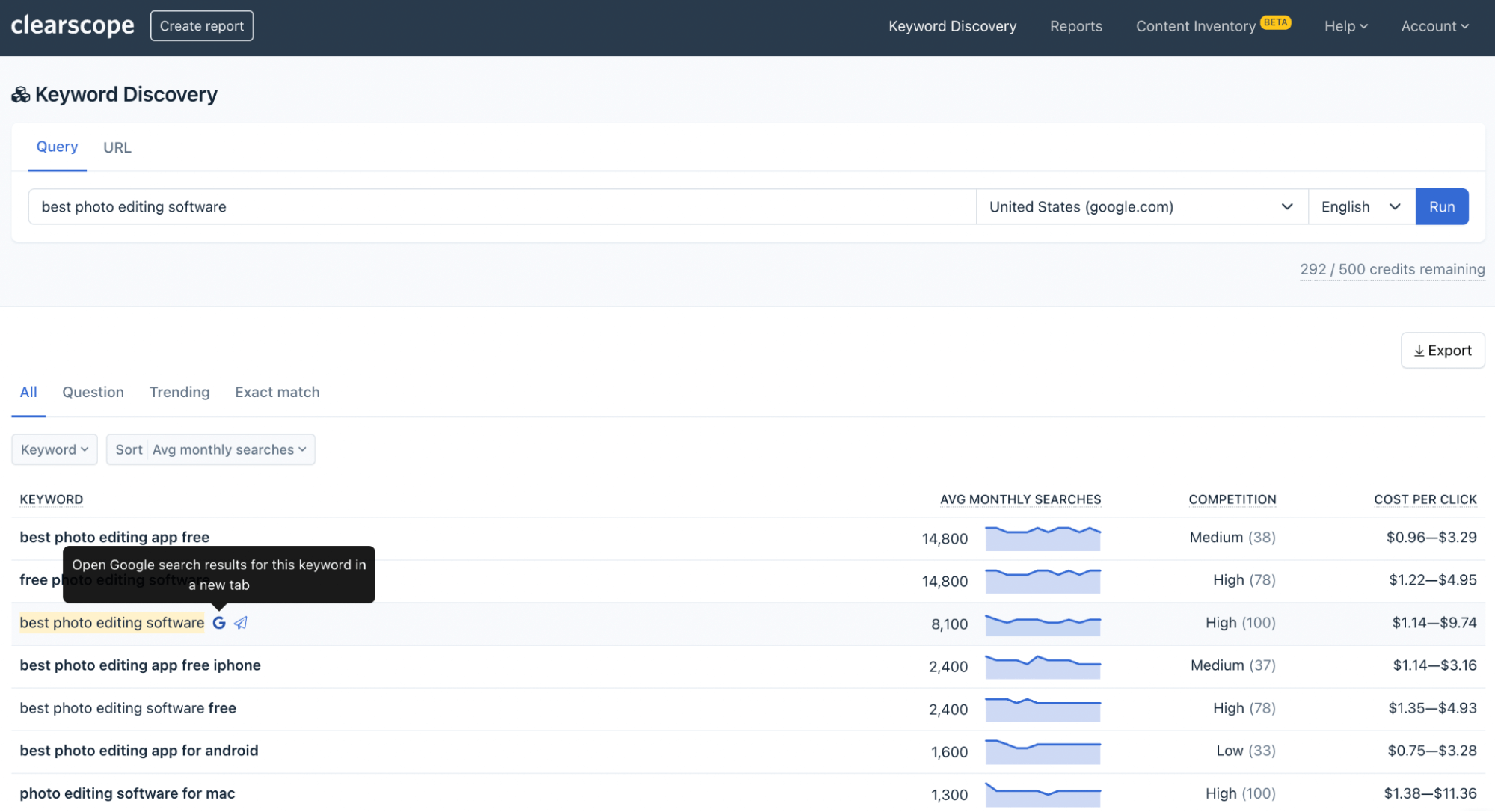
When you search by URL, you can see a list of keywords the page ranks for, including any trending topics.
Once you identify a keyword you’re interested in, you can click to open the Google search engine results page (SERP) and look at what’s already ranking, or you can generate a Clearscope Report to get started researching and planning page content.
Content Reports
Clearscope Content Reports can guide you through the entire writing process, from outlining to editing and updating. Inside each Report, you can navigate to the:
Editor — where you build out content (more on this below).
Term map — where you analyze suggested terms and see how similar sites cover each topic.
Competitors tab — where you can see a list of top-ranking pages for the target keyword, including each page’s word count, content grade, and rank positions on desktop and mobile devices.
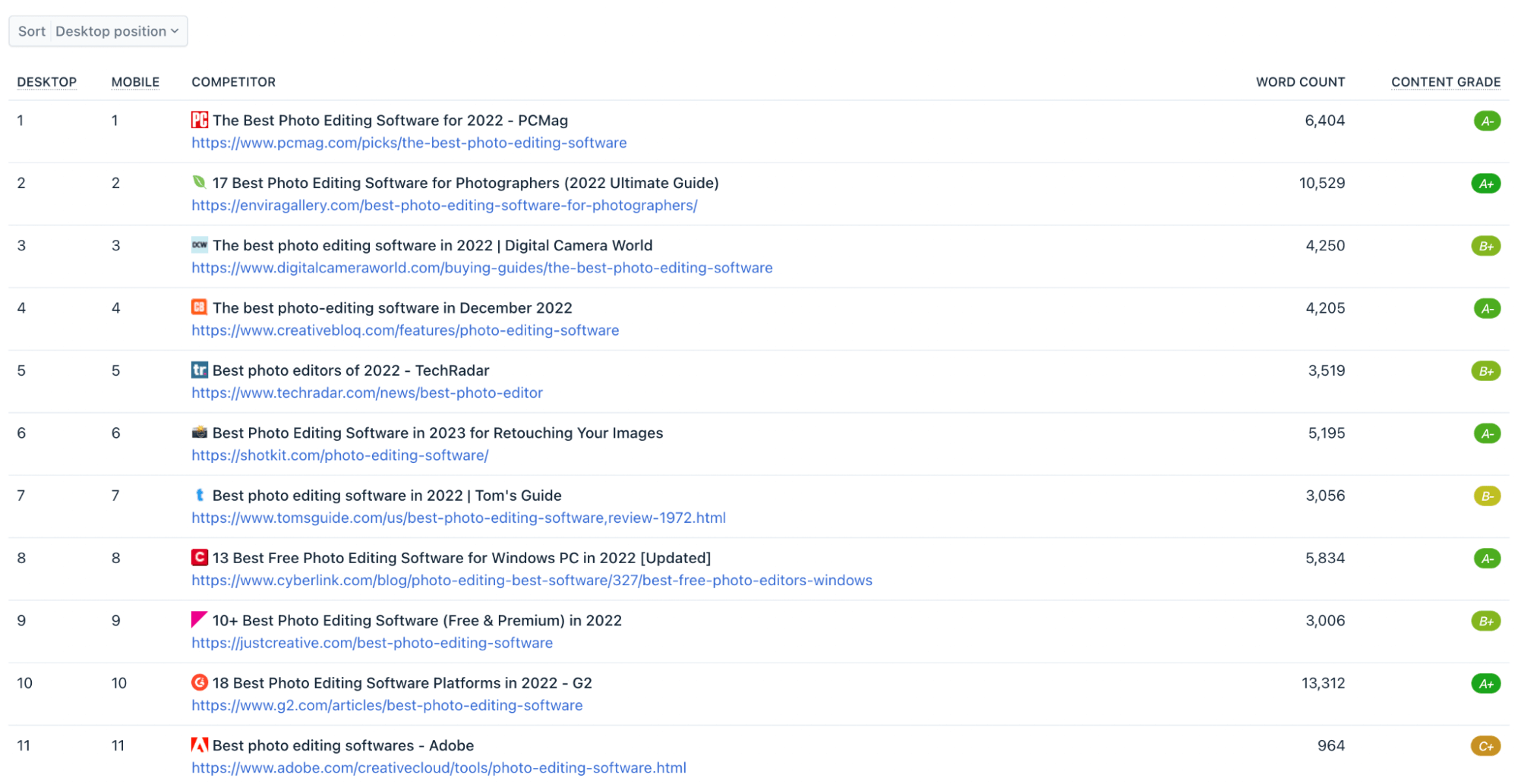
These features let you perform a comprehensive analysis of Google search results and get a feel for what you’ll want to talk about on your website pages. You can identify common themes between pages, identify strengths and weaknesses of what’s ranking, and start game planning content.
From there, you can use the Editor to outline page content and check recommended terms as you write. Let’s take a look at how the Editor works — here’s the report for “best photo editing software” as an example:

From the main view, you can see a list of terms (and header recommendations) with the suggested content grade, word count, and readability level. This view is most helpful when writing because you can check which terms you’ve already used, sort to see which terms you haven’t covered, and view all highlighted keywords in your text. You can also click on terms you’re unfamiliar with to see examples of how other sites cover the information.
Then we have the Research and Outline tabs where you can see common themes from competitor pages, a list of questions your content should answer, and proposed outline ideas.
You can reference Reports at any time during the writing process; many teams use Reports as they write but others use the Editor as an “SEO checker” after they write and edit content. Some teams feel like they should hold off on using on-page optimization tools until after they’ve written content because they don’t want their copy to sound too “keyword stuffy” — but we avoid that in a few ways:
We use Google and IBM natural language processing in combination with our proprietary AI to pull helpful keywords that aren’t redundant or “robotic.” And our AI can understand variations of keywords so you don’t have to incorporate the exact phrasings of the terms we gather.
We limit the number of keywords we suggest to <100 — the average is 70 — so you’re not overwhelmed with recommendations and tasked with checking (literally) hundreds of boxes.
We have a “Semantic grouping” feature that organizes related keywords so you have better context on how to naturally talk about recommended topics and information.
This way, you can use Content Reports as you write and it won’t impact the natural tone or flow of your copy. Then, once you’ve achieved your desired content grade, you’re ready to make final edits and publish.
We also have integrations with Google Docs and WordPress, so you can link reports and optimize content while you work in these tools.
Content Inventory
After you’ve published content, you can add the live URL to your Content Inventory and track its Clearscope score as time passes. You can add newly published content here, or pull old website pages and gauge their SEO health.
You can add and track hundreds of URLs in this tab to effectively monitor a) the content you have on your site and b) how well it’s optimized and performing for you.

Our SEO software is updated monthly with the latest SERP data: Our web scraping AI monitors how rankings change and can identify updated content on competitor sites. You can log in at any time to check your Content Inventory and see real-time content scores for saved URLs.
If you notice content scores drop, you can generate an updated Report and re-optimize the page. As we discussed above, Reports provide concrete recommendations so you know how to “bridge the gap” and improve SEO scores on your web pages. Typically, pages only need light refreshing to bring scores up, and if you stay on top of content, you’ll rarely need major overhauls.
Read more: How to Do a Content Audit in 5 Easy Steps [Template Included]
Compare alternative on-page SEO checkers
As we reviewed, Clearscope has three core features — a keyword research tool, Content Reports, and Content Inventory — so you can identify topics to write about, write SEO-optimized content, and monitor page performance to make sure content is consistently optimized for target keywords. But there are a few other common software solutions that offer similar functionality.
In this section, we talk about six other search engine optimization software and how you can use them in your processes.
Surfer SEO

Surfer is a content intelligence tool with features (like Clearscope) to research, write, optimize, and audit website content. They also have a “Grow Flow” dashboard that delivers personalized SEO insights with tips to improve website performance, and an AI outline generator so you can look at content ideas and streamline the writing process.
Reviews of Surfer say it helps you “decode” SEO and easily analyze competitor sites, map keyword opportunities, and write optimized website content. Reviewers also note that it’s a good tool for small businesses because they offer affordable entry-level packages.
But in our experience talking with customers that have switched to Clearscope from Surfer, we’ve noticed a few common notes:
Surfer’s content grader is difficult to learn and use — reports include hundreds of keywords and they provide dozens of “extra” insights to improve page score. It can take hours to optimize a single post to achieve your desired grade. (And in many cases, the small suggestions Surfer recommends aren’t significant enough to make any difference in page performance. Unless you’re an SEO expert, it’s hard to tell what suggestions are worth spending time on.)
Surfer’s content grader rarely recommends single-term keywords, often includes redundant terms, and can’t recognize variations of phrasings, so posts can sound “keyword stuffed” and clunky by the time you reach an ‘A’ grade.
Surfer’s on-page optimization tools are prescriptive to a fault — although it takes into consideration a wide variety of ranking factors, users find themselves “over-optimizing” posts in the content grader (and ultimately unhappy with the final product).
If you’re working with a tight budget, Surfer can be a good option to get you familiarized with on-page SEO software and the process for writing SEO-optimized content. But you may eventually consider an alternative solution with more precise content reports.
MarketMuse

MarketMuse is an AI-powered content planning and optimization software with features to:
Audit your current website pages to identify content gaps and opportunities to improve published content.
Research new keyword ideas.
Write new (optimized) website content.
A competitor of Clearscope, MarketMuse has many overlapping features to plan and optimize website content. Both platforms offer tools to simplify SEO and write content that ranks well.
However, user reviews of MarketMuse suggest the strengths of this solution are more in keyword research, as the audit tool helps identify ways to improve and build upon content that’s already published on your site. While MarketMuse offers helpful content reports, users cite a few cons:
Reports are not comprehensive, so you have to run one report to look at suggested terms, another report to look at FAQs, another to analyze Google search results, and so on and so forth. So you can run out of report credits quickly (unless you’re subscribed to the premium package).
Reports offer a lot of keyword suggestions, which can make writing overwhelming. There are also several redundancies between keyword suggestions and content can sometimes sound over-optimized.
MarketMuse offers extra insights to improve website page performance, but as with Surfer above, the extra suggestions are not always helpful, and you can spend time making changes that don’t make a difference.
Overall, MarketMuse receives good customer reviews — users say customer support is helpful and the interface is modern and intuitive. That said, reviews warn the platform is a little complex, given the extra bells and whistles, so training takes some time; but after you learn the ins and outs, it’s easy to take advantage of the available features.
MarketMuse falls on the expensive side — even the entry-level plan can be too expensive for smaller businesses (and many reviewers note MarketMuse’s hefty price tag). But for enterprise teams that already have a lot of content published on their site, are interested in a tool to identify content gaps, and have the budget to afford the software, MarketMuse may be a good solution.
Read more: Clearscope vs MarketMuse vs Surfer: A Detailed Comparison
Semrush

Semrush is one of the most robust SEO software on this list — and teams don’t usually invest in this software exclusively for on-page optimization tools. Instead, Semrush is a full-scale online marketing solution with features to:
Improve on-page and off-page SEO (i.e., check domain scores, analyze backlink profiles, identify technical issues on your site, etc).
Manage content marketing strategies and write optimized blog and website content.
Plan paid content like Google ads.
Build a social media strategy and track the success of your social channels.
Conduct personalized market research and analyze competitor websites.
They also have solutions for digital marketing agencies to manage client sites and page content.
However, if we zoom in and look at just Semrush’s on-page optimization tools, they might feel a little too surface-level for most teams. The writing assistant provides a handful of terms and topics to include in your content, but it doesn’t give you additional data: you can’t gather more details about the included terms, gauge the importance of topics, or understand which keywords to prioritize in your content.
Some teams will use Semrush’s writing assistant because it offers enough to get by, but it’s also not uncommon for teams to supplement Semrush with other SEO tools, like Clearscope.
As you might expect, Semrush has a pretty expensive price tag. It’s mostly reserved for experienced SEO marketers that understand all of the features, and know how to interpret data to make effective website changes and plan new marketing strategies.
Frase
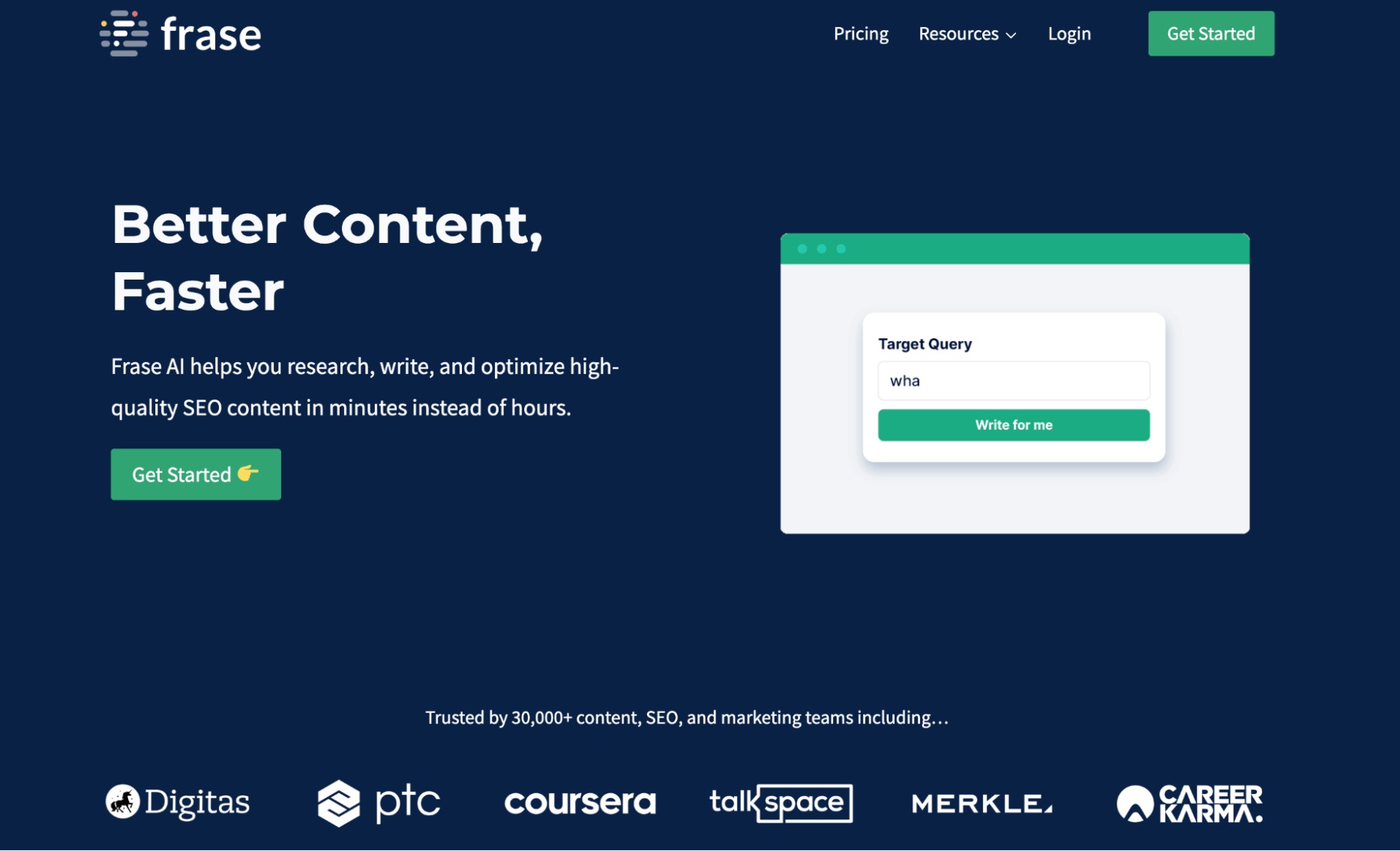
Next on our list is Frase: This solution offers on-page optimization tools and an AI content writer to speed up content creation. Reviewers praise Frase for its affordability and modern UX, and many users say the platform is user-friendly and easy to learn.
Frase’s tagline is “Better Content, Faster,” as many of their features are designed to help you write and publish content more efficiently. (This solution might appeal to teams that are tasked with managing multiple blogs or publishing a high volume of website content.) However, some negative reviews of Frase say its features aren’t as time-saving as you might expect:
The content briefs offer too many keywords — sometimes over 300 suggested terms and phrases — without additional data about their significance, so reports aren’t very in-depth or helpful.
Reports often have redundancies, and Frase doesn’t provide too many single-term suggestions. In a lot of cases, you have to write lengthy copy and weave in a lot of keywords to achieve a high content score.
While their AI writer offers a jumping-off point, it requires a lot of polishing, and many teams end up reworking a majority of the AI-written content.
Frase and Clearscope are comparable in terms of feature sets — they both offer content graders, AI-suggested outlines, and more — but one notable difference between the two is that Frase offers its keyword research tools for an additional cost. Frase’s main packages only include content reports and AI characters. But apart from add-on fees to access extra features, Frase is still a budget-friendly option for most teams.
Content Harmony
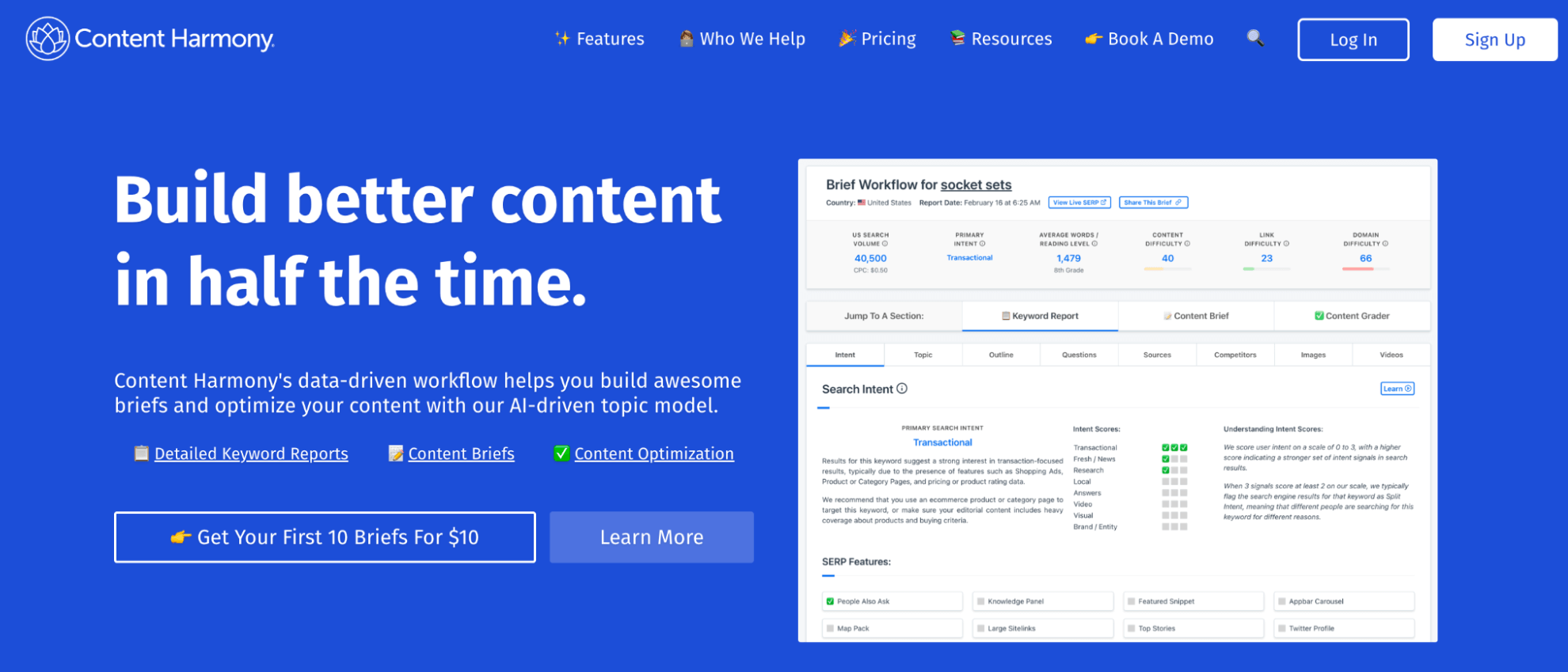
Content Harmony (CH) is an AI-driven on-page optimization software that often goes toe to toe with Clearscope. Both platforms have keyword research tools and reports that help users analyze Google SERP and write optimized website content. But let’s review Content Harmony’s core features so you can see the differences:
First, keyword reports cover a lot of detailed information — you can see content difficulty scores or review SERP features like “People Also Ask” and featured snippets. Content Harmony also shows you the search intent of the topic (navigational, commercial, informational, transactional). But the challenge here is that you have to know what keywords to search for. You can’t necessarily start keyword research on Content Harmony. But you can dig into keyword opportunities that you find from other research tools.
CH offers an automatic brief creator, but most of the AI-generated briefs are generic and require a lot of remixing to achieve a unique end product. Similar to Frase’s AI content writer, Content Harmony’s briefs offer a starting point for teams, but they aren’t as time-saving as they’re made out to be.
The CH content grader recommends a practical number of suggested terms and phrases, but it doesn’t provide any context about the suggestions, so it’s hard to do further research.
Another significant difference between Content Harmony and Clearscope is that CH doesn’t offer a content audit or inventory feature to monitor how website pages perform in the long term.
Aside from some of the mentioned cons, Content Harmony is a fairly new tool (so some fine-tuning of features and functionality is to be expected) and has received positive customer reviews since its debut. And they offer several packages to accommodate different business sizes.
Moz
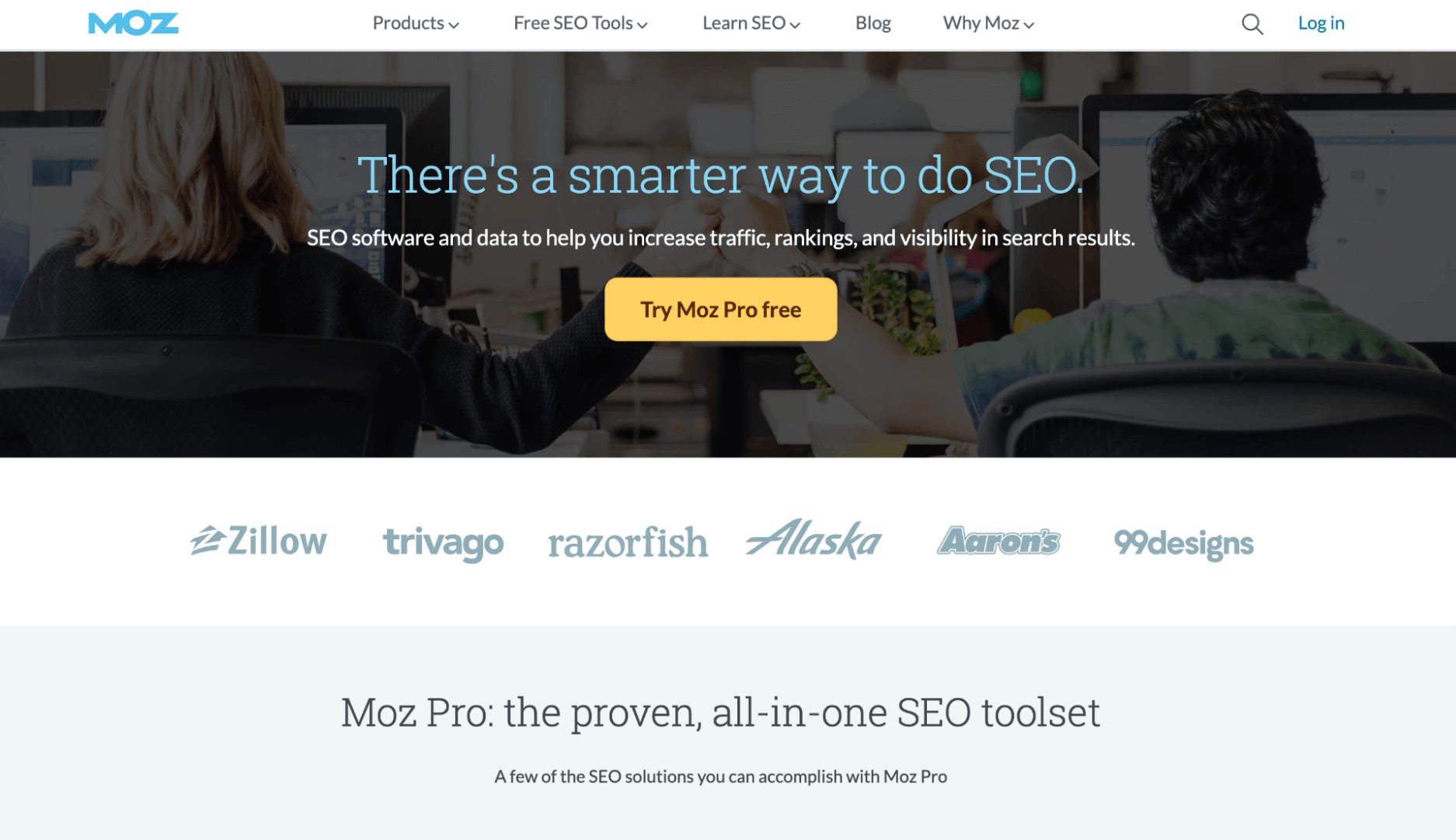
Last on our list is Moz. They offer a few different SEO products:
Moz Pro (this is most similar to Clearscope’s offerings) with tools to power keyword research, link building, site audits, and on-page optimization. They have features like Content Briefs to help you write optimized website content and rank for target keywords. They also have tools to help you write SEO-optimized title tags and meta descriptions for website pages.
Moz Local with features to distribute business information and manage local SEO, like listing updates and review management.
STAT, an enterprise rank tracker to monitor where pages appear in Google search results.
Mozscape API to provide insights on internal links and other SEO metrics.
They also provide a suite of free SEO tools (with limited monthly access) so you can explore keywords, analyze competitor websites, and discover link-building opportunities.
They have solutions (and pricing options) to suit a variety of professionals: from small businesses to digital marketing agencies and enterprise organizations. And they’re popular for teams that don’t have a ton of SEO experience because the features are all pretty easy to use and aren’t overly in-depth.
When looking at reviews of Moz, users note the easy setup and intuitive user experience, saying Moz is one of the simplest SEO tools to use.
However, negative reviews of Moz say the platform is a little too “basic” and the data isn’t super helpful. The keyword research tools don’t offer precise search volumes, and Content Briefs are a little too complex — lots of boxes to check, lots of ways to get dinged, and users sometimes have to sacrifice “natural” writing quality to appease the content grader.
When it comes to on-page optimization features, Moz may not be the most helpful, but reviewers praise Moz’s local SEO package.
Wrapping up: 7 On-Page Optimization Tools to Create & Update Site Content
Clearscope is a top-rated SEO software with user-friendly features to build out optimized website content:
research valuable keyword opportunities to get in front of the right audiences
write high-quality website content — that ranks on page one of Google search
monitor published content to make sure it remains relevant and ranking.




